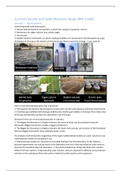Samenvatting
Samenvatting Bioreactor Design (BPE-21306)
- Instelling
- Wageningen University (WUR)
In deze samenvatting van het vak Bioreactor Design (BPE-21306), dat gegeven wordt aan Wageningen University, wordt alle theorie besproken die tijdens de colleges en werkcolleges is behandeld. Daarnaast is ook alle stof uit de reader die betrekking heeft op deze colleges en werkcolleges in de samenv...
[Meer zien]




